LDAP for
StreetTalk 3.5 Installation Guide
Introduction
LDAP for StreetTalk® software
is an adjunct to StreetTalk for Windows NT®. The
LDAP for StreetTalk service is based on the slapd source
code created by the University of Michigan.
LDAP for StreetTalk service software provides
read and write access to StreetTalk Directory Assistance (STDA)
items. You install the LDAP for StreetTalk software (version
3.5) on StreetTalk for Windows NT version 8.6 servers running
Microsoft Windows NT Server version 4.0.
For additional information about topics
in this guide, see the LDAP for StreetTalk Administrator's Guide.
System
Requirements
Your server must meet the following hardware
and software requirements before you install LDAP for StreetTalk:
Hardware

|
The recommended StreetTalk for Windows NT
server is a Pentium 200, or equivalent, with 128 MB of memory.
The minimum recommended server is a Pentium 90, or equivalent,
with at least 64 MB of memory. |

|
The size of the disk where your LDAP directory
is stored depends on the size of the directory. The recommended
amount of disk space is the same as, but in addition to, the
amount recommended in Managing Users and StreetTalk for
StreetTalk and STDA. (See "Calculating
Disk Space Requirements" in Chapter 10, STDA Services.) |

|
The LDAP for StreetTalk service does not run
on a backup domain controller (BDC). |
Software

|
Windows NT Server version 4.0. LDAP for StreetTalk
version 3.5 does not run on Windows NT Server version 3.51. |

|
StreetTalk for Windows NT version 8.6 or later. |

|
You must create an STDA service on the StreetTalk
for Windows NT server before you install LDAP for StreetTalk. |
Before
You Begin
Check the following before you begin the
installation:

|
You must install the LDAP for StreetTalk service
on a Window NT 4.0 NTFS file system where StreetTalk for Windows
NT is installed. |

|
Windows NT Servers must have an IP stack and
a WinSock 1.10-compliant winsock.dll installed in order to support
TCP/IP. |

|
You must have an STDA service on your StreetTalk
for Windows NT server and use StreetTalk Explorer to stop that
service before you install LDAP for StreetTalk software. |

|
If you have an existing LDAP for StreetTalk
service on your StreetTalk for Windows NT server, stop that service
before you install LDAP for StreetTalk. |
Note:
You can install the LDAP Configuration
Manager on a Windows 95/98 or Windows NT workstation or on a
Banyan Enterprise Client for Windows. You use the same installation
procedure as documented here but it allows you to install only
the LDAP Configuration Manager, the documentation, and the command
line utilities.
Installing
LDAP for StreetTalk
Overview
LDAP for StreetTalk software is available
on the Banyan web site, http://www.Banyan.com, as a self-extracting
compressed file, LDAPforStreetTalk.exe. There is also a patch,
PatchLDGetNames-ST_NT.exe, that you must install after installing
LDAP for StreetTalk. Download these self-extracting compressed
files to a temporary directory on your StreetTalk for Windows
NT server.
You will perform these steps:
This document describes these steps in
detail.
Note: Before you start the installation, stop any running
Windows applications.
Extracting
the LDAP for StreetTalk Software
You first extract the LDAP for StreetTalk
software from the self-extracting file LDAPforStreetTalk.exe:
1. Double-click LDAPforStreetTalk.exe,
or select Run from the Start menu, click Browse, navigate to
the directory where you downloaded LDAPforStreetTalk.exe, select
LDAPforStreetTalk.exe, click Open and then click OK.
The file is unpacked and the Choose Setup
Language screen appears.
2. Select the language version of the installation
program by selecting it from the dropdown box and click OK.
Caution: Do not install a language version of LDAP for
StreetTalk that differs from the language version that is already
present on your Windows NT server.

You can select English, French, German,
Japanese, and Spanish language versions of the installation program.
After the extraction process unpacks the
LDAPforStreetTalk.exe executable and you select the language
version, the LDAP for StreetTalk software installation starts
automatically.
3. Go to step 1
in "Installing the LDAP for StreetTalk Components."
Installing
the LDAP for StreetTalk Components
This installation loads the LDAP for StreetTalk
software components that you select on your StreetTalk for Windows
NT server. At the completion of the installation, you must create
the LDAP for StreetTalk service and set the LDAP directory suffix.
Note:
You can click Cancel at any time
(or press F3) and then select Exit Setup to exit the program,
or select Resume to continue. You can also select Back on most
screens to move back one screen at a time and make changes.
1. After you extract
the files, the Welcome screen appears. Read the Welcome screen
and, if you have no other Windows programs running, click Next
to continue.
Note: You can depress the ALT key and press the TAB key
to cycle through the programs that are running, and stop them.
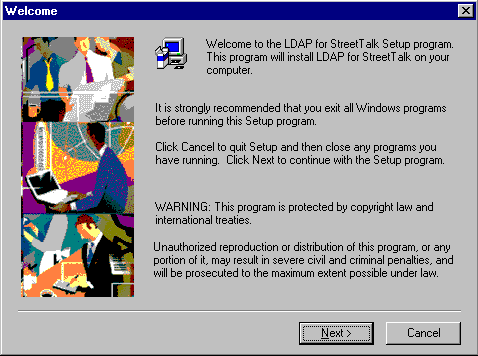
2. The license agreement appears. Read
the license agreement and click Yes to accept the conditions.
If you click No, LDAP for StreetTalk Setup exits. The User Information
screen appears.
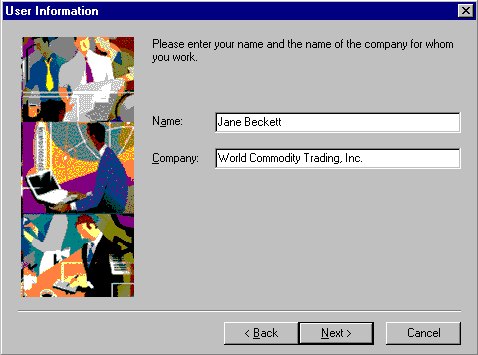
3. Enter your name and the name of your
company. If this information is in the Windows NT Registry, it
appears in the screen. You can change it in the screen but it
will not change what is in the Registry.
Click Next to continue. The Setup Type
screen appears.

4. Click on the installation type you want.
The three types (which are explained more fully below and in
step 5) are:

|
Typical - All components except the text version
of the release notice. |

|
Compact - LDAP for StreetTalk Service, StreetTalk
and STDA service updates, and the LDAP Configuration Manager. |

|
Custom - You can select: |
- LDAP for StreetTalk Service - Executable
and configuration files.
- StreetTalk and STDA Service Updates -
Updates for StreetTalk and StreetTalk Directory Assistance. When
you select the LDAP for StreetTalk Service, Setup automatically
selects the Service Updates.
Note: You install the StreetTalk Name Collector in a
separate procedure.
- LDAP Configuration Manager - Lets you
configure servers with the LDAP for StreetTalk service.
- LDAP for StreetTalk Documentation - Word
files of the installation guide, administrator's guide, and release
notice, and a text version of the release notice.
- LDAP Command Line Utilities - Tools for
the LDAP administrator and for Banyan support personnel to use
to debug any problems you may encounter.
Note: If you are installing the LDAP Configuration Manager
on a Windows 95/98 or a Windows NT workstation, select Custom.
Click Next to continue. If you select Typical
or Compact, go to step 6.
If you select Custom, the Select Components
screen appears. Go to step 5.
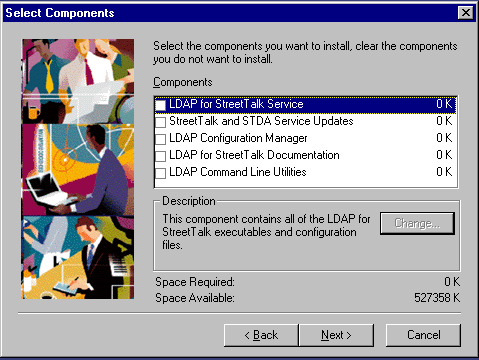
5. Select the
components to install. Banyan recommends that you install all
components. The components are:

|
LDAP for StreetTalk Service that lets you
create and configure the service. If you select this, you automatically
select the following updates. (5.9MB) |

|
StreetTalk and STDA Service Updates that update
your server software to allow it to be compatible with the LDAP
for StreetTalk service. You can also select these updates separately
if you first select and then deselect the LDAP for StreetTalk
service. (22 KB) |

|
LDAP Configuration Manager that lets you configure
the service. (1.1 MB) |

|
LDAP for StreetTalk
Documentation that includes the administrator's
guide and the release notice for the product. (15.6 MB) |

|
LDAP Command Line Utilities that let you test
and populate your LDAP database, and let Banyan support personnel
debug any problems that you may encounter. (2.3 MB) |
Note:
If you are installing the LDAP
Configuration Manager on a Windows 95/98 or Windows NT client,
you can select only the last three components and the installation
proceeds as documented. The LDAP for StreetTalk service runs
only on Windows NT Server 4.0.
Click Next to continue. The LDAP for StreetTalk
screen that lets you select the folder for the LDAP for StreetTalk
service database appears.

Note: If you have a previous version of LDAP in this
folder, Setup detects the previous version and defaults to the
folder for the previous version. Banyan recommends that you use
the default destination folder listed on the screen.
6. Click Browse
if you wish to change the default destination folder for the
LDAP for StreetTalk service, or accept the default if you will
not change the default destination. The default path is C:\Program
Files\Banyan\DATA\LDAP if you do not have a previous version
installed elsewhere. Click Next to continue. The LDAP for StreetTalk
Documentation screen appears.

7. Click Browse if you wish to change the
Destination Folder for the documentation. The default path is
C:\Program Files\Banyan Applications\LDAP for StreetTalk\Documentation.
Click Next to continue. The LDAP Configuration
Manager screen appears.

8. Click Browse if you wish to change the
destination folder for the LDAP Configuration Manager.
If this is a new installation, the default
path is C:\Program Files\Banyan Applications\LDAP for StreetTalk\
Configuration Manager.
If this is an existing installation, the
default path is C:\Program Files\Banyan\bin or wherever you installed
the older version.
Note: Because the version 3.x LDAP Configuration Manager
executable has a different filename than the version 1.0 LDAP
Configuration Manager, the old version remains on the disk after
this installation. You can put the new LDAP Configuration Manager
in the default folder, C:\Program Files\Banyan Applications\LDAP
for StreetTalk\Configuration Manager, and delete the old version
and its associated files from C:\Program Files\Banyan\bin if
you will not have a version 1.0 LDAP service. The version 1.0
Configuration Manager files all have ldapconf as the filename
with an appropriate extension.
Click Next to install the LDAP Configuration
Manager in the Destination Folder and continue. The LDAP Command
Line Utilities screen appears.
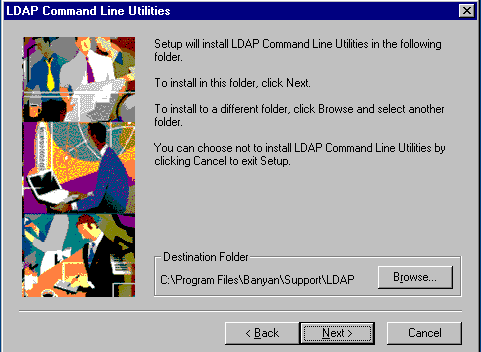
9. Click Browse if you wish to change the
destination folder for the LDAP Command Line Utilities. The default
path is C:\Program Files\Banyan\Support\LDAP.
Click Next to install the utilities in
the destination folder and continue. The Select Program Folder
screen appears.
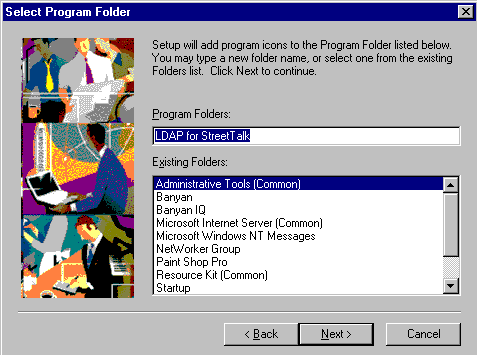
10. Accept the default folder, select a
folder from the Existing Folders list, or enter a new Program
Folder name to store the program icons in. Click Next to continue.
The Start Copying Files screen appears
and presents a summary of the selections you made. You can scroll
this screen to review your selections.
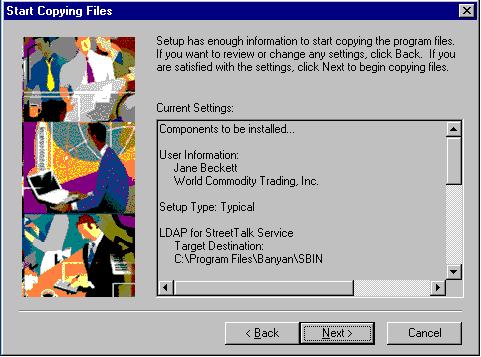
11. To change any of the settings listed
in the Current Settings window, click Back until you get to the
appropriate screen and go back to that step. If you are satisfied
with the current settings, click Next to start copying files
to their appropriate directories.
When file copying completes, the Setup
Complete screen appears displaying the components you installed
during this installation.
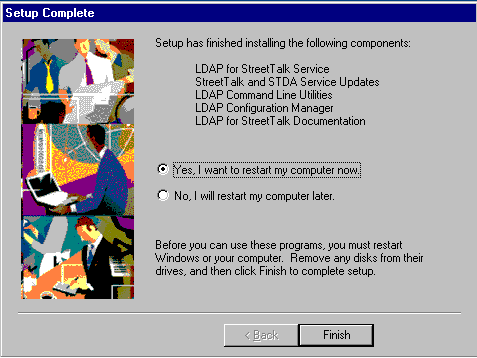
12. If the Yes and No radio buttons appear
on the screen, you must reboot. You can select No and reboot
manually later.
If you will now install the Name Collector
patch (see below), you may click No
and reboot after applying the patch.
The buttons appear if:

|
This is an upgrade and the LDAP for StreetTalk
service is running or |

|
Any of the Microsoft runtime libraries need
updating |
Click Finish to complete the installation
and exit the installation program.
Note:
If the Yes and No radio buttons
appear, you must reboot before you use StreetTalk Explorer to
create the LDAP for StreetTalk service and to obtain all of the
functionality of LDAP for StreetTalk. See "Creating
and Configuring Services" for instructions.
Installing
the Name Collector Patch
To use LDAP for StreetTalk 3.5, you must
install PatchLDGetNames-ST_NT.exe on the StreetTalk for Windows
NT 8.6 server where your LDAP service resides. This patch contains
the getnames executable, the StreetTalk Name Collector,
that is compatible with LDAP for StreetTalk 3.5. The patch is
available with the LDAP for StreetTalk 3.5 software on the Banyan
web site.
Caution: Do not apply this patch to any server other than
server that runs your LDAP for StreetTalk service.
To install the patch:
1. Double-click PatchLDGetNames-ST_NT.exe,
or select Run from the Start menu, click Browse, navigate to
the directory where you downloaded PatchLDGetNames-ST_NT.exe,
select PatchLDGetNames-ST_NT.exe, click Open and then click OK.
The Welcome screen appears. Read the screen.
Click Next to continue.
Note: If you this is an upgrade and LDAP is running,
click Cancel and exit the installation, use StreetTalk Explorer
to stop the LDAP service, and start the installation again.

2. The Patch Readme appears. Read the file.
When you finish reading the file, you must close it to continue.
Note: The Patch Readme is a temporary file. If you wish
to save it, select Save as from the File menu and save the file
with an appropriate name to a directory of your choice.
3. The Ready to apply Patch screen appears.
To apply the patch, click Next. To go back to the Readme, click
Back and then click Next on the Welcome screen.
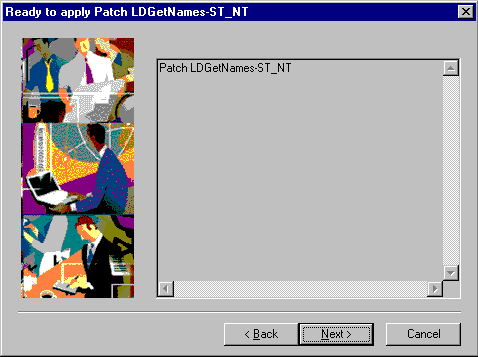
4. When the patch completes, the Setup
Complete screen appears.

If the Yes and No radio buttons appear,
you must reboot to obtain the functionality of the new Name Collector.
In addition, if you also just installed LDAP for StreetTalk and
put off rebooting at that time, you must reboot now. Click Finish
to complete the installation.
Note: Any StreetTalk for Windows NT patches that you
apply subsequent to applying this patch may necessitate that
you reapply this patch. If that is the case, the StreetTalk for
Windows NT patch readme will warn you of this.
Creating
and Configuring Services
You use StreetTalk Explorer to:
To Create
an STDA Service
1. Select StreetTalk, New,
Service or click the New Service icon.
2. In the New Service dialog box, enter
the StreetTalk name of the service, for example, STDA@servername@Servers.
3. Tab to the New description text box
and enter a description of the service.
4. Click Next. The Select a Service dialog
box appears.
5. Click Server Based Service and click
Next. The Select a Server dialog box appears.
6. In the Select a server drop-down box,
select the server that will maintain the service and configuration
data, and click Next. The Select a Service Type dialog box appears.
7. In the Select a Service Type dialog
box, select StreetTalk Directory Assistance and click Next. The
Select a Drive dialog box appears.
8. In the Drives dialog box select the
disk drive to store the service data and click Next. The STDA
Configuration dialog box appears.
9. Select Satellite or Master service and
click Next. The Create and Start dialog box appears.
If you select Satellite, the Satellite
Downloads drop-down box appears. Select each server to download
from in the Servers list box, click Add, click the type of information
to download from the Modify Download Information dialog box and
click OK. When done, click Next.
10. In the Create and Start dialog box,
read the Status window. You can click Back to make any changes.
If the data is satisfactory, click the Start after creation checkbox
to have the service start immediately after creation. Click Next
to complete creating and starting the StreetTalk Directory Assistance
(STDA) service.
11. Click Done.
To Set
Attribute 5:34
You must set attribute 5:34 to get the
full LDAP functionality.
1. Right-click the STDA service in StreetTalk
Explorer and select Attributes. The StreetTalk Attribute Editor
Open attribute window appears.
2. In the Vendor/Attribute pane, enter
the Vendor number (5) and Attribute number (34).
3. In the Open attribute as drop-down list,
select String attribute.
4. Click Open.
5. In the String attribute text window,
enter LdapConfig=On with no spaces in this string.
6. Select Attribute, Save in the StreetTalk
Attribute Editor window.
7. Select Attribute, Exit.
To Set
the List of Attributes that STDA Collects
1. Right-click the STDA service and select
Properties.
2. Select the Attribute Collection tab.
3. Click the Read from File button.
4. Click Collection, display, and indexing,
and click OK.
5. In the Open dialog box, navigate to
Program Files\Banyan\Data\STDA or to the folder where you installed
StreetTalk for Windows NT and select attrs.cfg. Select All Files
from the Files of type drop-down box to see the files in this
directory.
6. Click Open. Attributes and their characteristics
appear in the upper text box of the Attribute Collection property
sheet.
7. In the Class drop-down box, select All.
8. Click Apply or OK.
If you see a message about failure to notify
the service, that is because the service is not running. The
STDA service gets the new configuration information when you
start it.
See the LDAP
for StreetTalk Administrator's Guide for information
about the attrs.cfg file and attribute collection.
To Set
STDA to Rebuild the Database
1. Right-click the STDA service and select
Properties.
2. Select the Rebuild/Schedule tab.
3. Under Rebuild options, select Rebuild
database and delete display.
4. Click Rebuild Now.
To Create
the LDAP for StreetTalk Service
1. Select StreetTalk, New, Service or click
the New Service icon.
2. In the New Service dialog box, enter
the StreetTalk name of the service, for example, LDAP@servername@Servers.
3. Tab to the New description dialog box
and enter a description of the service.
4. Click Next.
5. In the Select a Service dialog box,
select Server Based Service and click Next.
6. In the Select a Server dialog box, select
the server that will maintain the service and configuration data,
and click Next.
7. In the Select a Service Type dialog
box, select StreetTalk LDAP Service and click Next.
8. In the Select a Drive dialog box select
the disk drive to store the service data and click Next.
9. Leave the Configuration dialog box blank
and click Next.
10. In the Create and Start dialog box,
read the Status window. You can click Back to make any changes.
If the data is satisfactory, click the Start after creation checkbox
to have the LDAP for StreetTalk service start immediately after
creation. Click Next to complete creating and starting the LDAP
for StreetTalk service.
11. Click Done.
Note: You may have to refresh the StreetTalk Explorer
pane to see the service listed.
Using
LDAP Configuration Manager
You run LDAP Configuration Manager to set
the LDAP directory suffix, which defines the location of the
STDA service within the LDAP directory information tree. The
suffix string is a comma-separated list of three values beginning
with the lowest LDAP entry and ending with the highest. Refer
to the LDAP
for StreetTalk Administrator's Guide for details about
LDAP names. See the LDAP Configuration Manager Help system for
help in configuration.
There are two types of configuration:

|
Local for setting the configuration of the
current server |

|
Network for setting the configuration of a
server on your network |
You must first set the configuration type
to Local Configuration and then set the Path to Configuration
Files to the local directory containing ldap.cnf:
1. Right-click the LDAP service in StreetTalk
Explorer and select Manage LDAP. The LDAP Configuration Manager
appears.
2. From the Open LDAP Configuration Files
dialog box, select the Local file radio button and click OK.
The Open dialog box appears.
3. Navigate to Program Files\Banyan\Data\LDAP\Config
(the default) or to the folder where StreetTalk for Windows NT
is installed.
4. Select LDAP Config Files in the Files
of type drop-down window.
5. Select the ldap.cnf file and click Open.
The configuration property sheets appear.
6. Click the Service Control tab.
7. In the Suffix text box, enter your suffix,
for example, l=Chicago,o=WCTUS,c=US, or any valid LDAP DN that
you choose to represent your directory subtree to the global
LDAP environment.
8. In the Default Database Access drop-down
window, select the appropriate type of access. Access is cumulative,
that is, Read/Write includes Read and Compare, Read includes
Compare.
Leave other settings at their default values
until you peruse the LDAP for StreetTalk Administrator's Guide.
9. Select Configure, Save As
and in the Save files to a local directory dialog box, click
OK.
10. In the Save As window, Navigate to
Program Files\Banyan\Data\LDAP\Config if not already there, click
Save and click Yes at the Save As message to update the existing
local configuration file.
Before you make any other configuration
changes, read the LDAP for StreetTalk Administrator's Guide.
Starting
and Stopping STDA and LDAP for StreetTalk Services
To start and stop the services, use StreetTalk
Explorer:

|
To start or stop STDA, select the STDA service
in the Browse window of StreetTalk Explorer. Then either select
StreetTalk, Properties, or right-click the STDA
service in the Browse window, select Properties, and click the
Start or Stop button on the Summary page. |

|
To start or stop the LDAP for StreetTalk service,
select the LDAP for StreetTalk service in the StreetTalk Explorer
Browse window. Then either select StreetTalk, Properties,
or right-click the LDAP service in the Browse window, select
Properties, and click the Start or Stop button on the Summary
page. |

|
To start or stop StreetTalk for Windows NT
services (StreetTalk, StreetTalk Server Service, StreetTalk Security,
StreetTalk File, StreetTalk Print, StreetTalk Intelligent Messaging),
see your StreetTalk
for Windows NT documentation. |
Installing the LDAP Configuration Manager
You can separately install the LDAP Configuration
Manager on Windows 95/98 or Windows NT workstations. If you install
the LDAP Configuration Manager on the StreetTalk for Windows
NT server from the LDAP for StreetTalk executable, follow the
appropriate parts of the "Installing
the LDAP for StreetTalk Components" procedure. Follow
the current procedure to separately install the LDAP Configuration
Manager.
You first extract the LDAP Configuration
Manager software from the self-extracting file LDAPConfigurationManager.exe:
1. Double-click LDAPforStreetTalk.exe,
or select Run from the Start menu, click Browse, navigate to
the directory where you downloaded LDAPforStreetTalk.exe, select
LDAPforStreetTalk.exe, click Open and then click OK.
The Choose Setup Language screen appears.

2. Select the language version of the installation
program by selecting it from the dropdown box and click OK.
Caution: Do not install a language version of LDAP for
StreetTalk that differs from the language version that is already
present on your Windows NT server.
You can select English, French, German,
Japanese, and Spanish language versions of the installation program.
After the extraction process unpacks the
LDAPforStreetTalk.exe executable, the LDAP for StreetTalk software
installation starts automatically.
3. The Welcome screen appears. Read the
Welcome screen and, if you have no other Windows programs running,
click Next to continue.
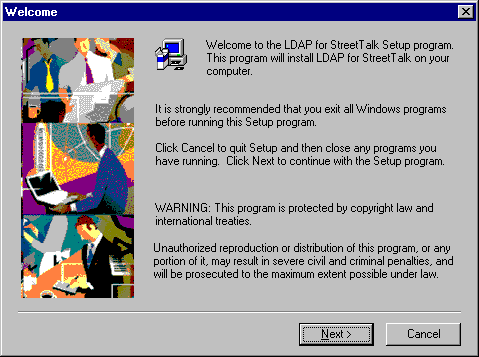
4. The Software License Agreement appears.
Read the license agreement and click Yes to accept the conditions.
The User Information screen appears.
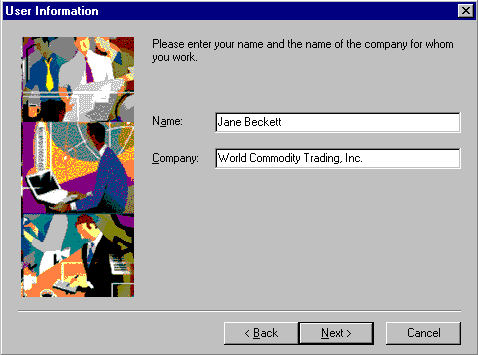
5. Enter your name and the name of your
company. If this information is in the Windows NT Registry, it
appears in the screen. You can change it in the screen but it
will not change what is in the Registry.
Click Next to continue.
6. The LDAP Configuration Manager screen
appears. Click Browse if you wish to change the destination folder
for the LDAP Configuration Manager. Click Next to accept the
default destination folder or to continue.
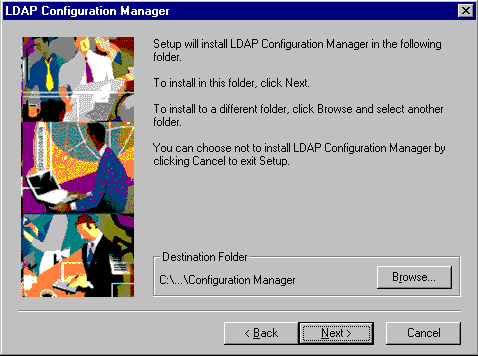
7. The Select Program Folder screen appears.
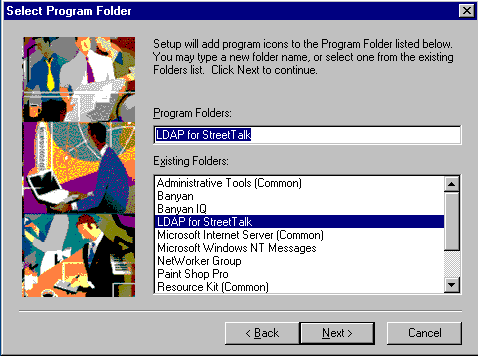
Accept the default folder, select a folder
from the Existing Folders list, or enter a new Program Folder
name to store the program icons in. Click Next to continue.
8. The Start Copying Files screen appears
and presents a summary of the selections you made and the components
that you will install. You can scroll this screen to review your
selections.
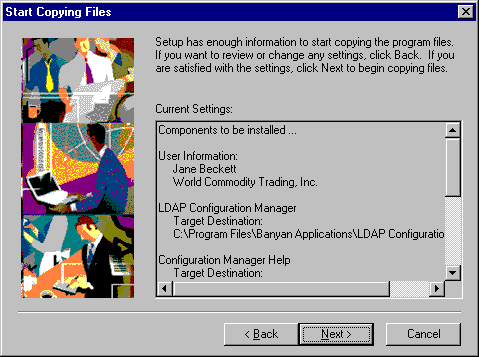
To change any of the settings listed in
the Current Settings window, click Back until you get to the
appropriate screen and go back to that step. If you are satisfied
with the current settings, click Next to start copying files
to their appropriate directories.
9. When file copying completes, the Setup
Complete screen appears displaying the components you installed
during this installation. Click Finish to complete the installation.

Uninstalling the LDAP for StreetTalk Service
Before uninstalling the LDAP for StreetTalk
Service, use StreetTalk Explorer to first stop the LDAP for StreetTalk
service (see "Starting and Stopping
STDA and LDAP for StreetTalk Services") and then to
delete it from StreetTalk (right-click the service and select
Delete).
Caution: If you
do not delete the LDAP service from StreetTalk before running
the LDAP uninstall program, Server service (SS@servername@Servers)
will crash when you reinstall the LDAP product and leave the
server in an inconsistent state.
You can uninstall both the LDAP for StreetTalk
Service and the LDAP Configuration Manager. On a Windows 95/98
or Windows NT workstation, use the same procedure to uninstall
the LDAP Configuration Manager.
Use Control Panel to uninstall LDAP for
StreetTalk:
1. Click Start, Settings, Control Panel.
2. Double-click Add/Remove Programs.
3. Select the component you want to uninstall,
LDAP for StreetTalk or LDAP Configuration Manager, and click
Add/Remove.
4. Follow the prompts to uninstall the
software. The server must be rebooted at the completion of the
removal process.
Note: If you see messages about removing shared files,
respond Yes to All to remove all LDAP shared files.






















